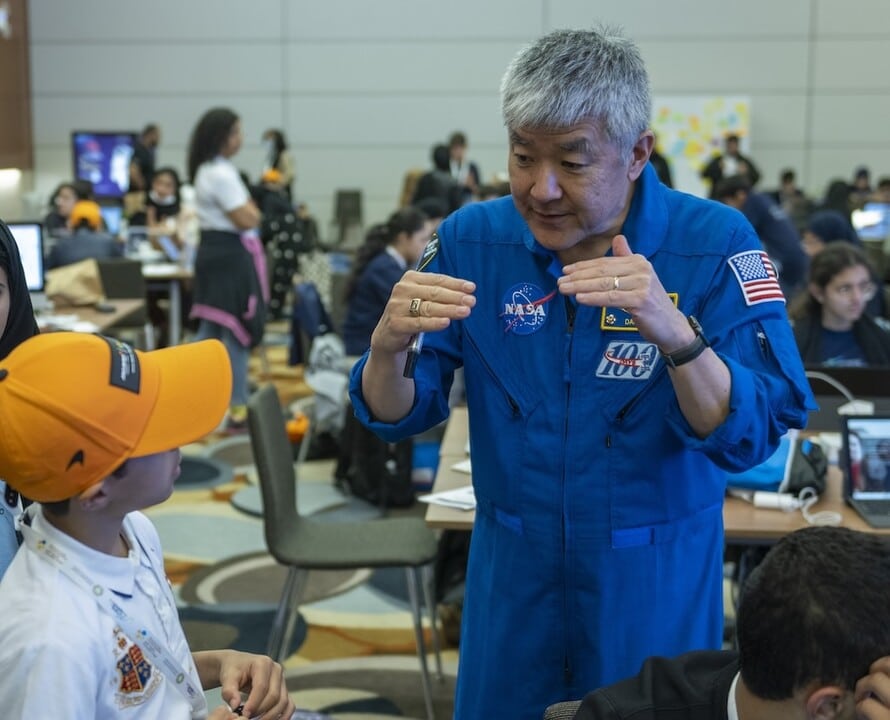Engaging students in the classroom, especially in subjects like math and science, has been a perennial challenge for educators. The traditional educational model often fails to ignite the natural curiosity and excitement that are crucial for learning, particularly in the STEM (Science, Technology, Engineering, and Mathematics) fields. In an effort to combat this issue, the integration of industry experts, such as astronauts, into educational settings has been explored as a potential solution.
Bridging the Gap with Real-World Experience
The presence of astronauts in educational environments offers a unique opportunity to connect students with real-world applications of STEM subjects. These professionals bring a wealth of experience and knowledge, and their stories of space exploration can serve as a powerful catalyst for student engagement.
The Inspirational Effect of Space Exploration
According to a survey, approximately 38 percent of young respondents between the ages of 18 to 34 strongly agreed that space exploration encourages young people to study math and science. This statistic highlights the potential impact that astronaut involvement in education could have on the aspirations and attitudes of students towards STEM subjects.
Educational Programs and Completion Rates
Programs like the High School Aerospace Scholars (HAS) in Texas demonstrate the interest and commitment that students can exhibit when given the chance to engage with space-related education. In the 2020-21 school year, 68% of the more than 900 Texas students who began the 16-week online HAS program successfully completed it, indicating a high level of engagement in a rigorous educational program.
NASA’s Commitment to Education
NASA’s Strategic Plan explicitly states the importance of engaging students to build the next generation of explorers. By including astronauts in the classroom, NASA fulfills part of its commitment to inspiring and educating future STEM professionals.
The Role of Astronauts in Enhancing STEM Learning
Astronauts can play a multifaceted role in enhancing STEM education, not just through their presence but also by actively participating in curriculum development and implementation. Here’s how they can make a difference:
- Real-life Applications: Astronauts can provide concrete examples of how STEM is applied in the field of space exploration, making abstract concepts more tangible.
- Career Inspiration: Meeting an astronaut can inspire students to pursue careers in STEM fields.
- Mentorship: Astronauts can serve as mentors, guiding students through complex topics and providing advice on educational and career paths.
- Challenging Stereotypes: By showcasing diverse individuals in the field of space exploration, astronauts can help to challenge STEM stereotypes that may deter some students from pursuing these subjects.
Table: Impact of Astronauts on Student Engagement
FactorDescriptionImpact LevelReal-World ExperienceDemonstrates the practical application of STEMHighInspirationProvides role models and career aspirationsHighMentorshipOffers guidance and personal insightMediumStereotype ChallengeBreaks down perceived barriers to STEM involvementMedium
Addressing the Pain Point: Low Student Engagement
One of the most significant challenges in education is low student engagement, particularly in STEM subjects. Studies indicate that student engagement is influenced by a variety of factors, both individual and school-level. Involving astronauts in the learning process directly addresses this pain point by providing students with an experiential learning opportunity that is both educational and inspirational.
Understanding the Impact of Astronaut Visits on Student Motivation
The interaction between students and astronauts can be particularly motivating. Astronauts who share their experiences can make the vast and complex field of space exploration feel more accessible. They embody the real-life application of what students learn in their textbooks, providing a compelling answer to the age-old student question, “When will I ever use this in real life?”
Engaging Through Storytelling
Astronauts are not just science and math professionals; they are also storytellers who have experienced something very few humans ever will. Their stories of training, missions, and life in space can captivate a classroom, making the science behind the stories come alive. This narrative approach to teaching can help cement abstract concepts into the minds of students, as they relate these concepts to the engaging stories they hear.
Hands-On Learning
Astronauts can also bring an element of hands-on learning to the classroom by involving students in simulations and experiments that relate to space exploration. This interactive approach aligns with educational research which indicates that student engagement increases when they are active participants in their learning rather than passive recipients of information.
Leveraging Technology to Enhance Engagement
Incorporating technology into interactions with astronauts allows for a more immersive and widespread impact. Virtual talks, webinars, and online Q&A sessions can reach a broader audience, ensuring that students from different geographical locations have the opportunity to benefit from these experiences.
Virtual Reality and Simulations
Virtual reality (VR) technology can take the influence of astronauts a step further by placing students in a simulated space environment. When combined with the guidance and expertise of an astronaut, VR experiences can be both educational and profoundly engaging, effectively bridging the gap between theoretical knowledge and practical application.
The Social Aspect of Learning with Astronauts
Learning is a social activity, and the presence of astronauts in educational settings creates a social buzz that can be harnessed to improve engagement. Students often work together in groups to solve problems posed by their astronaut guests, fostering collaboration and communication skills.
Peer-to-peer Learning
When an astronaut’s visit stimulates interest in a topic, students are more likely to discuss and explore that topic with their peers. This peer-to-peer learning can reinforce understanding and create a community of learners who support each other’s educational journeys.
The Long-Term Impact on Career Choices
The influence of astronauts on young learners goes beyond immediate engagement. These encounters can have a lasting impact on students’ career choices, steering them toward STEM fields. The HAS program in Texas is a testament to this, as it provides students with a glimpse into the world of aerospace and the careers that support space exploration.
The Role of Role Models
Having role models in STEM is crucial for young students, particularly for underrepresented groups in these fields. The presence of astronauts from diverse backgrounds can inspire a wider range of students to see themselves in similar roles, effectively expanding the pool of future STEM talent.
Challenges and Considerations
Despite the benefits, there are challenges to incorporating astronauts into educational programs. Availability is a significant issue, as active astronauts have demanding schedules. Cost can also be a factor, as not all schools have the resources to facilitate these visits, whether in person or virtually.
Overcoming Accessibility Issues
To overcome these challenges, schools and educational programs can seek partnerships with organizations like NASA and other space industry players. Grants and sponsorships can also provide the necessary funding to make these interactions possible.
Conclusion
The case for astronauts in the classroom is strong. They bring expertise, inspiration, and real-world applications to STEM education, addressing the critical issue of student engagement. While there are logistical challenges to consider, the potential benefits for students’ educational experiences and career trajectories make it a worthwhile endeavor. As we continue to look for ways to inspire the next generation of scientists, engineers, and explorers, astronauts will undoubtedly play a pivotal role in igniting the spark of curiosity and ambition in young minds.

